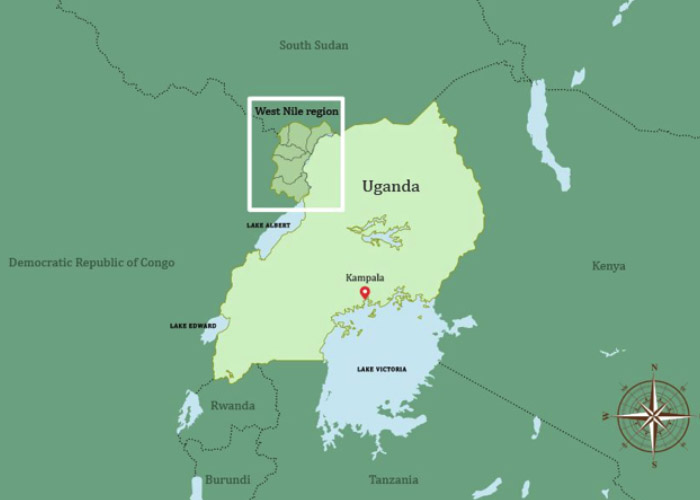The West-Nile Region
West-Nile region is located in the upper north-western part of Uganda. The region stretches from the northern shores of Lake Albert to the South-Sudanese border. It lies between the White Nile river and The Eastern Ituri border of the DRC and is geographically more related to north-eastern DRC than northern Uganda.
West-Nile was first invaded by Arab slave traders from Turco-Egyptian Sudan before it was taken over by western imperial armies (Leopold, 2005). West-Nile region was originally part of the ‘’Lado Enclave’’, named after the town Lado, a river port in South-Sudan within the former Congo Free State. The enclave roughly covered the area of North-Eastern Congo, Northern Uganda and Southern equatorial Sudan (Acemah, 2013). In 1910, when the Belgian King Leopold died, the region came under control of the Anglo-Egyptians after the Anglo-German treaty of 1890 whose outcome divided the region and borders to the situation as it still is nowadays. In 1915 the new boundaries of the Ugandan protectorate were officially recognized by the two colonial powers of the region, Belgium and Britain (Acemah, 2013).
For the British the inclusion of West-Nile within their protectorate meant they regained control of the Nile River from its source in Uganda up to Cairo, Egypt. The Lado enclave (including West-Nile region) was famous for its wildlife abundance. As Mark Leopold stated in his book “Inside West-Nile” (2005, 12); ‘’The Lado became a playground, and a killing ground, for white adventurers, the last place in Africa in which unrestricted, unregulated, elephant hunting was possible’
The history of West-Nile can be seen as dynamic and violent. Mark Leopold (2005) writes that the region is seen by outsiders as a violent and dangerous place or better said; marginalized and brutal. As a result, the colonial army recruited many soldiers from the region for the King’s African Rifles. Probably the most notorious person originating from West-Nile was former president and field marshal Idi Amin who served for many years in the colonial army (The King’s African Rifles). Due to the understanding of West-Nile as a marginalized and brutal place, policies and actions did not work out in favour of the region. Neither have the recent Ituri, DRC and Sudanese conflicts that still have a significant influence on the regional development. Due to its border location, between the two countries, the local socio-economic situation of West-Nilers (people living in West-Nile region) was and is always influenced by the cross-border dynamics (commodity trade and migration) (Titeca, 2009).
West-Nile can be seen as a multi ethnic region, the predominant ethnic groups living in the region are the Alur in the south, the Lugbara in the middle and west, the Kakwa in the north west, and the Madi in the east covering the Nile river plains. The one thing they all have in common is that their ancestral boundaries are international in nature (Acemah, 2012). The Alur and Lugbara are both living in Uganda and the DRC. As for the Kakwa, their lands are in the DRC, South-Sudan and Uganda. For that reason, the West-Nilers are inseparably connected with their ethnic brothers and sisters across the contemporary borders which were made up by the colonial rulers in the early 20th century (Leopold, 2005).
Cross border dynamics and trade in West-Nile
The regional cross border trade is besides agricultural production one of the main economic drivers of West-Nile, this is mainly due to its location between North-East Congo and South-Sudan. Ugandan traders are primarily involved and in power of the trade flows and networks. This is a result of a strong movement of refugees in the region in the past 30 to 40 years. The refugee movement was provoked due to a fear of revenge after Idi Amin was removed from power in 1979. Most of the West-Nilers, predominantly the Kakwa people, fled to neighbouring countries. During the 80s most of the Kakwa’s lived in exile for five up to ten years. Similarly, the civil wars in Sudan forced many Sudanese to take refuge in northern Uganda as well did the eastern Congolese who had to flee for the civil war in Ituri, DRC (Titeca, 2009).


